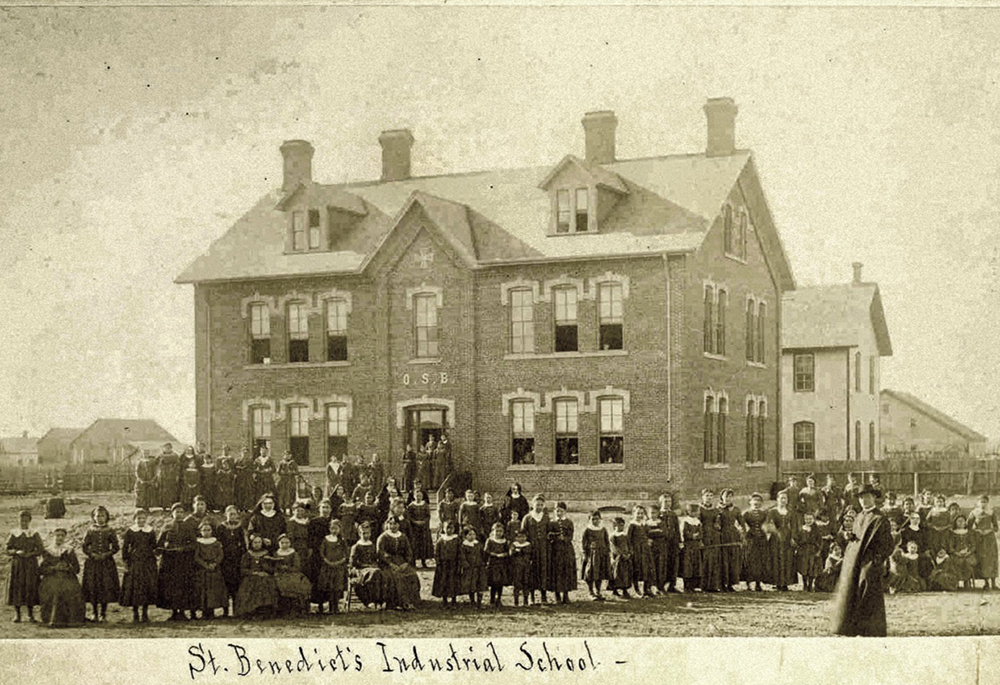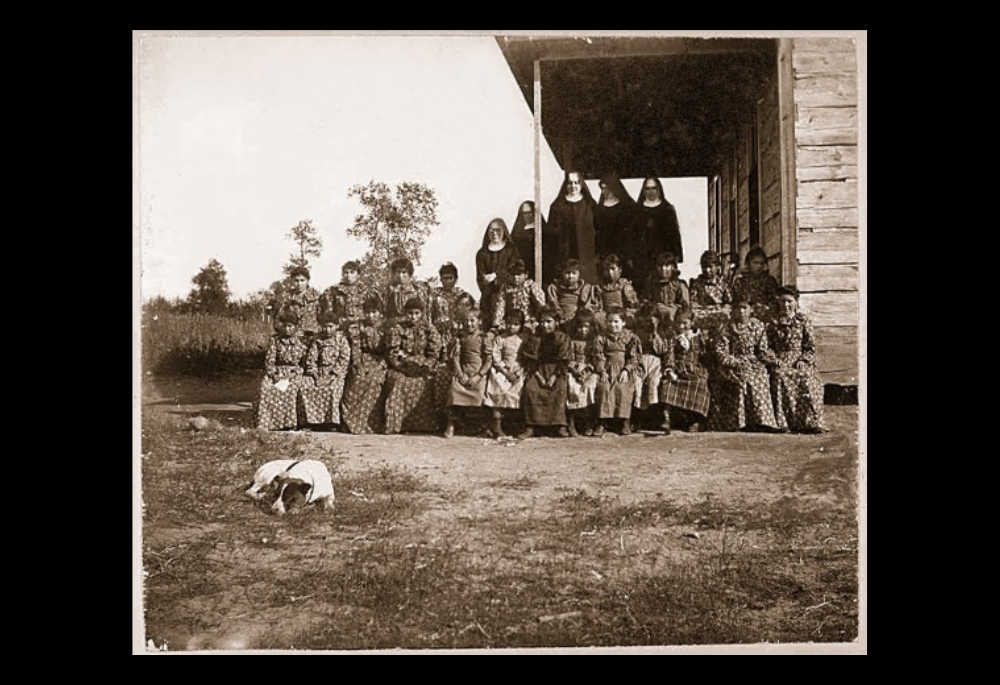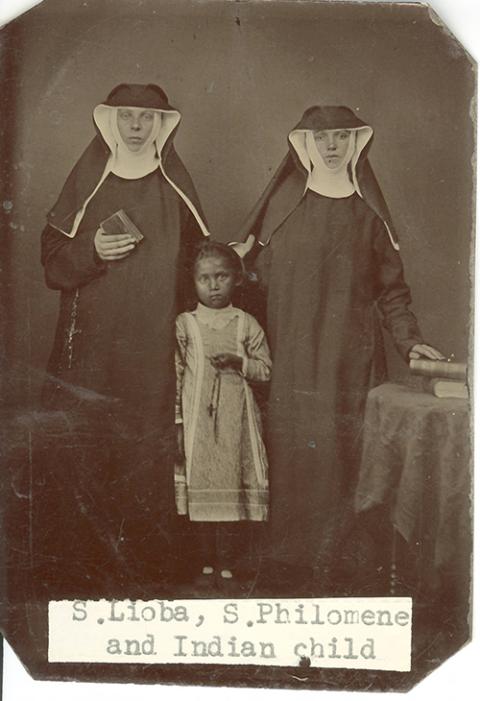
Students, sisters, and a priest pose before the newly reconstructed St. Benedict's Industrial School, an off-reservation boarding school for students from the White Earth Tribe in Minnesota, in 1886. ("Indian Girls Industrial School," College of Saint Benedict/Saint John's University Libraries, https://csbsjulib.omeka.net/items/show/915)
For 150 years, the United States government financed more than 400 boarding schools across the United States, educating tens of thousands of Native American children but subjecting them to abuse, neglect, cultural oppression, and sometimes even death.
But while the government has a list of every Navy ship the nation has floated, it has never compiled a list of the boarding schools it ran.
"There was no central place where all this information was held," said Brenna Cussen, who for the last two years has been part of a committee of the Catholic Native Boarding School Accountability and Healing Project, known as the AHP, which is compiling such a list. Cussen is also the religious communities liaison for the Nuns and Nones Land Justice Project.
Almost two dozen people sit on the AHP's archives committee, most of whom are archivists for religious congregations or members of orders with archives containing boarding school records. Together, they are working on a comprehensive list of schools Catholic entities ran from the 1820s to the 1960s as part of its wider work to address the role the church played in the U.S. government's attempted cultural genocide.
The list, which the group hopes to publish in May, will allow Indigenous people who attended the schools or who have ancestors that did to find information about the school, who ran it, and where school records are located.

Sisters and students at Red Lake Indian school 1889 ("Sisters and students at Red Lake mission school," College of Saint Benedict/Saint John's University Libraries, https://csbsjulib.omeka.net/items/show/919)
In 2022, the U.S. Department of the Interior released an initial report on the nation's boarding schools that included a list that government researchers compiled based mostly on funding reports to Congress. That list excludes the system's many day schools, and though religious organizations supported or ran about half of the boarding schools listed, most of those associations are vague or unclear.
Global Sisters Report's research of the Department of the Interior list found at least 56 schools connected to Catholic women religious from 33 different congregations. Sisters either ran the school or staffed it for a diocese or another organization, such as the Jesuits.
If the government list references a religious congregation, often, it says the school was run by "the sisters" or mentions a broad group of sisters, such as the Benedictines, almost never identifying individual congregations.
Previously, the only national list of schools that existed was one created by retired professor and author Denise Lajimodiere, and it only included the name of the school and its location. But schools often changed names, or they had an official name but were known colloquially as something shorter or simply by the name of the closest town.
The Marquette University archives created an online index of Catholic ministries that involved Native communities, but it is limited to the materials that congregations or dioceses shared with the archive and is only a list of the various collections of records the archives holds.
Jaime Arsenault, the tribal historic preservation officer for the White Earth Nation in north central Minnesota, said archival documents and materials relating to tribal nations are often fragmented and scattered throughout multiple institutions, many of which are located a long way from the community and might not be digitized or even organized. This makes it difficult when searching for records relating to boarding schools.

Benedictine Srs. Lioba Braun and Philomena Ketten pose for a photograph with a child presumed to be from the Ojibwe Tribe in the 1880s. Braun and Ketten were part of St. Benedict's Mission for members of White Earth Nation in Minnesota. ("Sisters Lioba Braun and Philomena Ketten with Ojibwe child," College of Saint Benedict/Saint John's University Libraries, https://csbsjulib.omeka.net/
items/show/923)
"I've had individuals contact me because they're just trying to find out where their grandfather was taken," Arsenault said. "For many individuals, it's the not-knowing that is the hardest part."
The government report showed the schools were rife with corporal punishment, including solitary confinement, withholding food, and whipping and other physical abuse. More than 500 children died at 19 of the schools, and burial sites have been found at 53 schools over the 150-year period — numbers that are expected to rise as the Department of the Interior continues its research. It is unknown when the next report may be released.
The schools were part of an effort to eradicate Native American culture; in the words of the system's architect, to "kill the Indian" and "save the man." The government forced the children to attend the schools, which threw out their traditional clothing and cut their long hair. The students were punished for speaking any language other than English or practicing Native traditions or religions. About seven generations of Native Americans attended the schools, Arsenault said.
One major challenge with creating a list of sister-run boarding schools is the structure of some of the schools and the Catholic Church itself.
Schools were often created or funded by one person or group, such as St. Katharine Drexel or her congregation, the Sisters of the Blessed Sacrament, then staffed by sisters from a different congregation. Sometimes, they were run by a diocese that changed several times as territories became states and as dioceses that covered huge areas were divided into smaller ones. Those schools could have been run by a succession of diocesan staff or religious orders. For example, GSR found schools in Oklahoma and Wyoming that were each staffed by three different congregations of sisters over the years.
Those making the list, Cussen said, want to include where former students or their relatives can find the records associated with a school. But the diocese or one or more congregations could have held the records, or that entity may have donated them to a university or other group.
Sometimes, the congregations don't exist anymore. For example, the Lady Missionaries of Mary staffed one school in Washington state from 1908 to 1936; that congregation later became part of the Spokane Dominicans, who ran the school from 1936 to 1965 and later merged into the Dominican Sisters of Sinsinawa, Wisconsin.
The congregation today has very few records from that era, said Sinsinawa Dominican Sr. Toni Harris.
"We would have inherited the list of sisters, but we don't have a lot of material about the school," Harris said. "We didn't keep the enrollment records."
Advertisement
Trying to follow that document trail through the multifaceted structures of the Catholic Church can be bewildering or even appear deliberately evasive. For example, the Franciscan Sisters of Philadelphia are separate and distinct from the Franciscan Sisters of Penance and Christian Charity, though both are Franciscan; just as tribal nations are separate and distinct.
"One of the biggest problems with our list is we also want a list for each school of the Native communities that were impacted," Cussen said. Schools often had students from multiple tribes but may only be associated with one or use a name that is so vague it is unhelpful. "Currently, that information is woefully inaccurate, and we want to fix that, or at least make it not as offensive as it is right now. Like, the records might just say 'Chippewa,' but that covers many tribal nations, all of which are independent of each other. That's not a helpful way to find your ancestors."
Arsenault, who is also part of the committee, said some information on the list will likely change over time as tribal nations have the opportunity to review the list, share their knowledge, and correct errors, such as misspellings of community names or locations.
"We do have oral histories and some records and other historic documents, so hopefully we'll be able to piece together different things for different individuals," she said. "Individuals are still looking for and sorting through thousands of pages of documents, some of which are written in French or Latin and might need to be translated."
Tribal members are part of the AHP, and the archivists committee is also working with tribal historic preservation officers from across the country to prepare them for when the list is published later this year. Members want to ensure the officers are familiar with the list and how it works so they are ready if there is a flood of inquiries from tribal members looking for school records about themselves or their ancestors once the list is released.
"You're going to get one answer and a hundred more questions," Arsenault said. "We need to prepare ourselves. ... It's not just this distant subject; it's something that could hit home for them."

Female students show their handiwork at St. Benedict's Mission School on the White Earth Indian Reservation in Minnesota in the 1890s. ("Work room at St. Benedict's Mission School," College of Saint Benedict/Saint John's University Libraries, https://csbsjulib.omeka.net/items/show/928)
Separately, the Archivists for Congregations of Women Religious has created a resource guide for congregations to help them organize their records and make available those that can legally be released. Meg Paulino, archivist for the Franciscan Sisters of Perpetual Adoration, said those practices will be critical.
"Every individual archive — it doesn't matter whether it's women religious or a museum or anything else — has individual standards on what they keep because space is such a premium," Paulino said. "And how do you locate what is in your archives? Because that's subject to the archivist who filed that paperwork and what was their thought process."
Also unknown: what is and isn't in those archives. Often, congregations that ran boarding schools only have records on the sisters who were there and little or no documentation of the students.
For example, the Franciscan Sisters of Perpetual Adoration ran a boarding school on the Bad River Reservation, 250 miles north of the motherhouse in La Crosse, Wisconsin. If the mother superior had to discipline a sister at the school in, say, 1920, "would it go into her personnel file? Or would it be in the school records?" Paulino said. "They got to the place by canoe. Sending paperwork home was a difficult task."
Digital archives can help the search process but also have pitfalls, she said; for example, leave out the period in "St. Mary's," and the documents may not appear in a search. Paulino said her congregation's records have been digitized and given to the Bad River Tribe, and she also helps tribal members search Marquette's online records.
"I've welcomed them to our archives and let them look at what we have," she said. "I really do as much as I can do, but I hit walls where I just don't have any information."
The missing information could be critical: Names misspelled over the decades could mean a tribal member doesn't qualify for health or nutrition benefits because they can't prove their heritage. School records — if they can be found — could correct that.
Arsenault said despite the problems with documentation, congregations may have other things that mean even more. Because children were taken to boarding schools as young as 5 years old and sometimes did not return home for years or at all, the families of the former students have no photographs, memories or shared experiences of birthdays or holidays. A congregation could have a scrapbook of photos from the school.
"There are generations of families that were completely disrupted. So to have something tangible ... if there's a photograph of a child that can be named, that may be the only photograph that family has of their relative," Arsenault said. "That one photograph might really, really matter to somebody."
The list is taking a long time to create, but Arsenault said she understands.
"You can't rush through something like this. It takes a while to look for these details and find information. There are so many layers, and it's so complex," she said.
But there is also no time to waste.
"Many individuals who consider themselves survivors are of advanced age, and they don't have a lot of time to wait for all this. So there's a sense of urgency as you try to do the best work possible."







